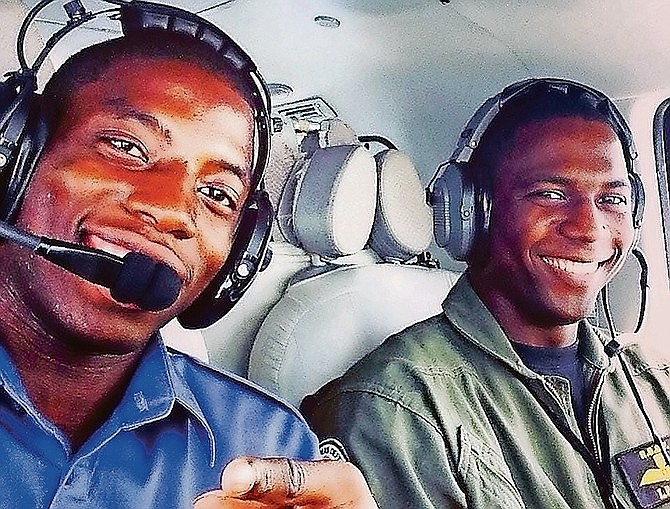PILOTS who died in a plane crash in Abaco last month did not properly configure the settings on the aircraft for takeoff, investigators say in their report on the crash.
The jet destroyed airport lighting equipment and broke several trees along its path, according to the official report from the Air Accident Investigation Department.
Lavan Paul, a former defence force officer, and Jason Allen, a marine, were pilots of the plane which crashed on July 5.
The two foreign pilots who flew the plane into Abaco from the Dominican Republic later filed a stolen plane report.
The Tribune understands that police have been following various leads relating to the incident. However, the Royal Bahamas Police Force has so far declined to describe the nature of their investigation to the press.
Investigators have said the pilots lacked the type rating needed to fly the plane.
The AAIA has concluded that the probable cause of the plane crash is the failure of the craft to climb as required. Contributing factors to the crash include the unfamiliarity of the pilots with the aircraft systems and the failure of the crew to configure the aircraft for proper takeoff.
The AAIA said: “A trail of aviation fuel and pieces of the aircraft and avionics equipment from the flight deck, were left behind before the aircraft finally hit a small mound (hill), spinning, hitting several additional trees, breaking apart and bursting into flames. The aircraft came to rest at coordinates 26°45’21.50”N, 77°24’7.26”W, approximately 2,000 feet (.33 miles) from the end of runway 32.”
“As this airport did not have a fire truck or crash and rescue personnel stationed on site, assistance with fire services were requested from the town. Two firetrucks from the township responded, however, due to the location of the crash, and no access road available, the trucks were unable to reach the crash site and assist in extinguishing the blaze. The fire continued unimpeded, dampened only by the intermittent downpour of rain, which did not aid in extinguishing the blaze, but rather, only limited the spread of the fire to surrounding bushes. The raging fire totally destroyed the aircraft and much of the control surfaces and components in the direct area of the blaze.”
The flight was headed to Marsh Harbour as its final destination, according to the transire signed by the pilots. However, the AAIA said it is unclear where the aircraft was to travel because the destination in the flight plan differed from the destination approved on the Transire Form C38.
The AAIA said: “A witness recalled that both pilots were sitting in the aircraft for about 40 mins before starting both engines and proceeding to runway 32 for departure. According to several witnesses, during the departure, there were cloud build-ups but no rain.
“Eyewitnesses also stated that at the time of departure, N790JR entered the threshold of runway 32, accelerated down the entire runway, but never become airborne. Damages to the runway edge light and approach lights of runway 14 were noted, confirming eyewitness statements of the aircraft never becoming airborne.
“A witness mentioned, ‘when present at the airport we look to see planes get in the air, noticing this did not happen. I called the baggage handler and we proceed down the runway, we saw white smoke as we continue off in the bush was what appears to be an explosion.”
“The aircraft landing gear left behind indentation on the surface of the ground about 60-80 feet from the threshold of runway 14. As the wing struck the approach lights, it created a hole in the left-wing, as evidence of fuel burn to the underbrush and fuel trail marks were evident and led to the crash site. Along its flight path, and closer to the mound that was struck, pine trees were dislodged, ground scarring was evident and pieces of aircraft and avionics from the flight deck and other debris were strewn about on the ground, leading up to the final resting place of the aircraft.
“The tail of the aircraft which included the elevator, horizontal stabilizer, vertical fin and rudder (which control movements of the aircraft), was detached and lodged in between two pine trees, thereby separating the fuselage of the aircraft from the tail section.
“During onsite inspection of the wreckage, there were still smouldering aircraft parts and components which hindered efforts to closely examine all components of the aircraft. A search was made for the Cockpit Voice Recorder and/or Flight Data Recorder (which would have revealed a more accurate account of what transpired) to no avail. All avionics and other components located in the aft section of the aircraft where recorders are housed, were all destroyed by impact and the post-crash fire. Most of the aircraft, with the exception of a few components and control surfaces that were strewn about, out of the direct path of the fire, was destroyed by the post-crash fire.
“During documentation of the scene and wreckage, 2 undamaged locking pins, which were later identified as thrust reverser locking pins were discovered amongst the wreckage, out of the direct path of the fire. The locking pins are used as safety features to protect the aircraft against unseen mishaps when parked or not in use but must be removed before a flight as it can disrupt aircraft systems from functioning at its full capacity. (It could not be determined whether the pins were installed at the time of the crash or whether they were removed prior and thrown from the aircraft when the aircraft broke apart).





Comments
tribanon 2 years, 8 months ago
Thankfully no other lives were lost as a result of the recklessness of the two unqualified pilots.
Sign in to comment
Or login with:
OpenID